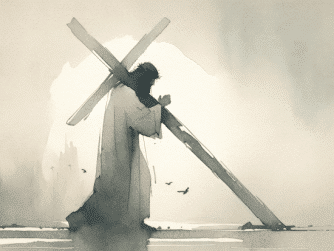The parable of the five foolish virgins is often used as a metaphor for the rapture of the church, yet this Jewish wedding story holds important clues which must be rightly interpreted. We mustn’t forget, in this famous parable Jesus refers to ten virgins, not ‘brides.’ Who or what exactly, do these mysterious virgins represent? In this final broadcast of the rapture series, Carl gives nine reasons why the pre-tribulation rapture of the church is the most compelling interpretation. Let’s join him now…
Here is a complete transcript of the podcast (below)…
Friend, this is my fourth and final broadcast on the rapture of the church and we’ve covered quite a bit of ground in the past few days. We have studied key eschatological passages from 1 Corinthians 15, 1st and 2nd Thessalonians, Johns Gospel, Jude and finally the book of Revelation. Hopefully by now you’re confident of your removal from the earth in the rapture, prior to the tribulation period, which signifies our escape from God’s soon coming wrath, to be poured out upon unbelievers who dwell on the earth. Now one of the passages some people use to try and justify the rapture of the church with some people being taken and others left behind, is the Parable of the Five Foolish Virgins.
This is a wedding story that Jesus gave in Matthew 25:2-13 and I will read it to you now: “Then shall the kingdom of heaven be likened unto ten virgins, which took their lamps, and went forth to meet the bridegroom. 2 And five of them were wise, and five were foolish. 3 They that were foolish took their lamps, and took no oil with them: 4 But the wise took oil in their vessels with their lamps. 5 While the bridegroom tarried, they all slumbered and slept. 6 And at midnight there was a cry made, Behold, the bridegroom cometh; go ye out to meet him. 7 Then all those virgins arose, and trimmed their lamps. 8 And the foolish said unto the wise, Give us of your oil; for our lamps are gone out. 9 But the wise answered, saying, Not so; lest there be not enough for us and you: but go ye rather to them that sell, and buy for yourselves. 10 And while they went to buy, the bridegroom came; and they that were ready went in with him to the marriage: and the door was shut. 11 Afterward came also the other virgins, saying, pLord, Lord, open to us. 12 But he answered and said, Verily I say unto you, I know you not. 13 Watch therefore, for ye know neither the day nor the hour wherein the Son of man cometh.”
Friend, this parable is not about the rapture of the church as I will explain. It’s the nation of Israel that’s represented in this passage and they’ve been sleeping for 2000 years with regard to the true identity of Jesus as Messiah. In verse 5 it says; while the bridegroom tarried, they all went to sleep. Because Israel is asleep, it will miss the rapture friend. Did you notice that Jesus is talking about ten virgins, not ten brides? The bridegroom is not marrying the virgin’s friend. The bride is the church. It doesn’t say 5 brides were foolish and five brides were wise, no. In Jewish tradition, when the marriage was consummated between bridegroom and bride the bridegroom would go to the home of the bride to fetch her and bring her to his house. But as he approached his own home, check this out; he would be met by a procession of virgins who would guide the bride and bridegroom to their wedding ceremony. These virgins would then join the marriage feast in celebration with the bride and groom.
The people listening to Jesus speak this parable would’ve understood this but we in the west don’t have a working knowledge of these Jewish traditions of matrimony. So, when the bridegroom, which is Jesus the Messiah—returns to earth with His Bride the church at His second coming, at the end of the tribulation period, the virgins will be responsible for both watching for His return, and being ready to light the lamps for the ceremony. Therefore, these virgins represent members of the nation of Israel who will be saved during the tribulation period. Remember, the five wise virgins were ready and watching with oil in their lamps, which represents their life. But the five foolish virgins are unbelievers because they have no oil in their lamps at all and oil is a type of the Holy Spirit friend as we all know. It says in verse 12 that Jesus never knew them, so they can’t be saved and also, they had no oil with them, not that they ran out of oil and there is a difference friend. Anyways, I thought I’d share that with you friend, as there is much confusion around some of these parables. In the coming days I will do a broadcast on some of Jesus more popular or perhaps obscure parables so stay tuned. So, let me now share some of the reasons why I believe the pre-tribulation view is the most accurate way to interpret the rapture of the church. I have 9 reasons in fact:
1) Noah and Lot as Examples: The tribulation period is compared to the times of Noah and Lot by Jesus in Luke 17:26-28. The two circumstances that Noah and Lot shared were the removal of the righteous and subsequent judgment of the wicked in their dispensation. Noah and his family were removed in an Ark and Lott’s family escaped from Sodom and Gomorrah by angels after Abraham interceded for them. Abraham acted like a type of Christ in this instance because he petitioned God for the righteous in the city. This is called ‘setting a precedent’ in scripture or the ‘law of first mention.’ Once a precedent is set, God is not capricious friend and does not change His mind or the way he does things. These examples serve as a typology for the removal of the godly into safety and future judgments upon the ungodly, resulting in destruction. Another significant aspect of the Days of Noah is that Godly seed was being tampered with. In the days before the flood, it describes in Gen 6 of there being giants in the land before and after the flood. These were the progeny of rebellious watcher angels who saw the daughters of men as fair and took wives of them. As the book of Jude verse 6 states, these angels kept not their first estate, and later became bound in Tartarus because of their indiscretion. Right now, friend, the seeds of the earth are being tampered with like never before. We have genetically modified seeds in our food chain and no-one really knows the long-term consequences to our DNA structure, for making this change. The seed war began in Gen 3:15 and has never stopped since. Even now, in laboratories all around the world nations are splicing the DNA of humans and animals to create chimera’s that Dr Moreau would be proud of. In April 2016 a three-parent baby was born in Mexico. Things are getting freaky out their people, to say the least.
2) The Marriage Supper of the Lamb: Luke 12:36 states that when Christ returns, He will be returning from a wedding. In Revelation 19:7-8, we read about the marriage itself. The marriage supper takes place before the marriage friend. According to Jewish custom, the marriage contract, which often includes a dowry, which was drawn up first. This contract parallels our act of faith when we trust Jesus to be our Savior. The dowry is His life, which was sacrificed to purchase us. However, a dowry by definition is what a wife brings to her husband at marriage, so we (the bride) are bringing trust in the husband (Jesus) as dowry when he returns to consummate the marriage, amen! This union occurs in heaven at the same time as the Tribulation on earth. We the church are then clothed our wedding garments which comprises a ‘gown of salvation’ and ‘robe of righteousness’ so that we return fully clothed with Jesus at the Second Coming (Rev 19:14). When it’s time for the wedding, the groom goes to the bride’s house unannounced. She comes out to meet him, and then he takes her to his father’s house. This precisely correlates with the events according to the pre-tribulation rapture viewpoint, i.e., Jesus (the Groom) comes down from heaven and calls up the Church (His Bride). After meeting in the air, He and His Bride return to His Father’s house (which is heaven). Then the marriage supper will take place, while on earth the final events of the tribulation will transpire as God pours out His wrath. After the marriage supper of course, the bride and groom are presented to the world as man and wife. This corresponds to the time when Jesus returns to earth accompanied by an army “clothed in fine linen, white and clean” (Rev 19:14). This army is comprised of the church or bride of Christ which is now ready to be presented with her garments to the world.
3) “Come Up Hither”: Many pre-trib writers cite Revelation 4:1, which says, “come up hither,” as a prophetic reference to the rapture of the Church, leaving Revelation chapters 1 through 3 as a description of the Church Age. After the shout to “come up hither,” the Church is not mentioned in Scripture. The attention of Scripture switches from the Church to the Jews living in Israel from that point onward. Notice the “voice” in Rev 4:1 sounds like a trumpet talking to the Apostle John. This is the same trump that accompanies the rapture, described in 1 Thess 4:16. The voice speaking to the Apostle John was that of a ‘trumpet’ or (the trump of God). Notice it is the trump of God and not a trumpet blown by an angel in the Book of revelation as part of the judgments of God’s wrath.
4) The Time of Jacob’s Trouble (not the church’s trouble): In several passages, the Bible refers to the tribulation as a time of trouble for the Jews. The phrase “Jacob’s trouble” pertains to the descendants of Jacob, not the church. Jeremiah 30:7 says this time of Jacob’s trouble will come just before the Lord returns to save His people the Jews and everyone else who gets saved during the tribulation. Daniel’s 70th week or tribulation is yet to take place for Israel. An angel told Daniel that, “70 weeks are determined unto thy people (that’s the Jews not Christians)” in Dan 9:24. Scripture never mentions the tribulation is a time of testing for Christians. It’s a time of testing for Israel, because they’ve rejected Jesus as Messiah.
5) Armies in Fine Linen: When Jesus returns (Rev. 19:18), an army follows Him. This army is riding on white horses, and they are clothed in ‘fine linen, white and clean.’ Friend, we are that army. This is also a description of the righteous saints of the Church in Jude 14. In Revelation 19:8, we’re told fine linen is granted to the righteous. If the saints are returning with Christ our conquering King to wage war on the Antichrist, then it’s not possible to have a simultaneous post-tribulation rapture without us running into ourselves.
6) My Father’s House: – We should not ignore the amazing parallels of Jn 14:1-3 and 1 Thess 4:13-18. Many scholars believe John 14:1-3 is a rapture reference as I’ve stated previously. Several scholars including Renald Showers and J.B. Smith have rendered the first part of John 14 as not speaking of a promise for dead saints but the rapture of the church. This ‘coming’ is for His own and does not concern His coming for the Jewish remnant or to establish His kingdom on the earth.
7) Preterist Theory: Many groups try to discredit the pre-trib rapture by saying most of the end-time events in the Bible have already taken place but this cannot be so. A group called ‘preterists‘ claim the Book of Revelation was mostly fulfilled in 70 AD when the Jewish temple was destroyed and Romans ransacked Jerusalem. If the events described in the Book of Revelation took place in the past, they do not account for: the rebirth of Israel, the reunification of Europe, cataclysmic meteorite impacts, the opening of the bottomless pit, the development of nuclear weapons, 100-pound hailstones falling from the sky and the sea turning to blood. There are numerous events on a global level that clearly didn’t occur in 70 AD, which meet the literal description of the Book of Revelation. Friend, this clearly refutes the Preterist’s viewpoint.
8) War or Rapture (Rev 19:19-21): When Jesus returns at the end of the tribulation, He will be coming for battle as a conquering King of Kings. For those who believe in a post-tribulation rapture, it would seem strange to meet our Lord and Savior (in the air), just as He’s rushing into battle. The idea that war and rapture could occur simultaneously is difficult to perceive, especially since they transpire at the same moment according to the post-tribulation proponents.
9) God Takes an Inventory: In Revelation 7:3, an angel descends to earth and seals the servants of God. Two bits of information about this sealing highly disclaim a post-tribulation viewpoint. The first item is the number of people sealed: 144,000. The second one is that all those who are sealed are from the 12 tribes of Israel. For the events in Revelation 7:3-8 to be true in a post-tribulation interpretation, either the Church has turned against God or God has turned against the Church. Friend the reason the church is not mentioned, is it’s already in heaven!
Friend, this concludes our final broadcast on the rapture of the church that has now spanned four broadcasts. At any time soon I hope to see you in the air my friend, when we meet the Lord together.
https://carljosephministries.com/podcast/the-last-trump-a-call-to-rapture/
https://www.kingjamesbibleonline.org/parable-of-the-ten-virgins_bible/
Title: The Rapture: Part 4
Related keyword searches:








